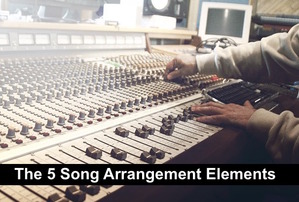- in Book Excerpt , Production by Bobby Owsinski
- |
- 1 comments
A Look At The 5 Song Arrangement Elements
 One of the major jobs of both a producer and a mixer is to arrange the song if needed (and it usually is). Anyone that’s been working in a studio for a while learns that there are 5 kinds of arrangement elements that make up a song. You can have fewer than 5 happening simultaneously (most songs do in several places), but having any more than 5 generally confuses the listener as the arrangement becomes too cluttered.
One of the major jobs of both a producer and a mixer is to arrange the song if needed (and it usually is). Anyone that’s been working in a studio for a while learns that there are 5 kinds of arrangement elements that make up a song. You can have fewer than 5 happening simultaneously (most songs do in several places), but having any more than 5 generally confuses the listener as the arrangement becomes too cluttered.
Here’s an excerpt from the latest edition of my Music Producer’s Handbook (there’s also something similar in my Mixing Engineer’s Handbook as well) that explains these elements.
“Some songwriters already have the arrangement worked out in their head as to how they want the rest of the band to play, but for most songwriters (even the most accomplished) that’s a skill that has to be developed or have the job passed on to a specialist. In order to understand how the arrangement influences the song, we have to understand the mechanics of a well-written arrangement first.
Most well conceived arrangements are limited in the number of elements that occur at the same time. An element can be a single instrument like a lead guitar or a vocal, or it can be a group of instruments like the bass and drums, a doubled guitar line, a group of backing vocals, etc. Generally, a group of instruments playing exactly the same rhythm is considered an element. Examples: a doubled lead guitar or doubled vocal is a single element, as is a lead vocal with two additional harmonies. Two lead guitars playing two different parts are two elements, however. A lead and a rhythm guitar are two separate elements as well.
Here are the typical arrangement elements that makes up most of modern music:
• Foundation – The Rhythm Section. The foundation is usually the bass and drums, but can also include a rhythm guitar and/or keys if they’re playing the same rhythmic figure as the rhythm section. Occasionally, as in the case of power trios, the Foundation element will only consist of drums since the bass will usually have to play a different rhythm figure to fill out the sound, so it becomes it’s own element.
• Pad – A Pad is a long sustaining note or chord. In the days before synthesizers, a Hammond Organ provided the best pad and was joined later by the Fender Rhodes electric piano. Synthesizers now provide the majority of pads but a real string section or a guitar power chord can also suffice.
• Rhythm – Rhythm is any instrument that plays counter to the Foundation element. This can be a double time shaker or tambourine, a rhythm guitar strumming on the backbeat, or congas playing a Latin feel. The Rhythm element is used to add motion and excitement to the track.
• Lead – A lead vocal, lead instrument or solo.
• Fills – Fills generally occur in the spaces between Lead lines, or can be a signature line. You can think of a Fill element as an answer to the Lead.
Remember that usually there should not be more than four arrangement elements playing at the same time. Sometimes three elements can work very well. Very rarely will five simultaneous elements work together.”
To read additional excerpts from The Music Producer’s Handbook 2nd edition and my other books, go to the excerpts section of bobbyowsinski.com.

